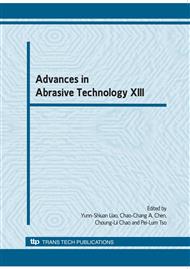p.744
p.755
p.760
p.767
p.773
p.779
p.785
p.791
p.796
Experimental Study on Milling Hardened SKD Steel Using Micro CBN Ball-End Mills
Abstract:
Micro ball-end milling process features the ability of machining complex surfaces, precision machining accuracy, and excellent machined surface roughness. However, because the diameter of a micro milling tool is very small, a rapid progress of tool wear or even tool breakage usually happens when machining a high-strength hardened mold steel using improper machining parameters. As a result, the machining cost would rise due to the quality defect in machined workpiece. In this study, to investigate how the machining parameters affect the cutting behaviors, a series of experiments using micro CBN ball-end mills with a diameter of 0.5 mm were performed to cut the SKD11 mold steel with hardness of HRC 61. The machining parameters are selected as the feeding speed (f) being 840, 960 and 1,080 mm/min, depth of cut (ap) being 30, 45, 60 μm, and spindle speed (vs) being fixed as 30,000 rpm. According to the experimental results, the measured three-axis cutting forces, flank wears, and surface roughness of machined workpiece are highly related to the cutting length. It is expected that the measured results can be used to construct a performance function of a micro ball-end tool. With referring to the performance function, the tool life can be well expected, and thus a progress in machining efficiency without tool failure can be achieved.
Info:
Periodical:
Pages:
773-778
Citation:
Online since:
August 2010
Price:
Сopyright:
© 2010 Trans Tech Publications Ltd. All Rights Reserved
Share:
Citation:


